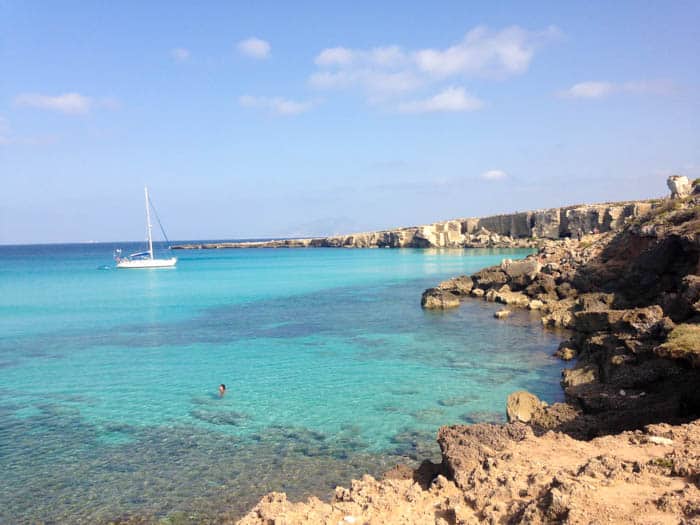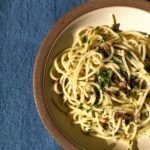
Last time, I wrote a post, it was all about the amazing archaeological site of Segesta in Sicily. This time, I thought it would be great to introduce you to a delicacy made in Sicily. Bottarga al Tonno, or cured tuna roe (it sounds much better in Italian!) is this brown lump you see in the photo below. This is one of those occasions in which you shouldn’t judge a book by its cover, as my mother always says. The pungent odour and vibrant taste of the bottarga will win any fish-lover over as soon as they take their first mouthful. In fact, it seems to be almost addictive for those who like it. My eldest son and husband can’t get enough of it. When we visited Sicily and went to the Osteria i Vitelloni in Trapani, my son ordered two plates of it, one after the other, and went back to the kitchen to congratulate the chef afterwards. It turns out the chef, Gianni Zichichi, is renown for his cuisine in the culinary world, and has won a slew of awards, so it was very cool that he took the time to have a chat with a 12 year old who appreciated his food!
Bottarga making seems to stretch back in history so far that it’s origins are clouded in the mists of time. Imagine: the method used in modern times for making it is the same that was used about 3000 years ago by the Phoenicians! As it is a very delicate process to extract the intact egg sac from the tuna (or mullet), this part of the job must still be done by hand. The egg sac is then washed, salted, pressed between heavy objects, like wooden planks, for a couple of weeks, then air-dried for a while. It keeps for a very long time, and is very protein-rich, which is probably why it was made in the first place all those thousands of years ago. The process of making bottarga shows up in history all through the Eastern Mediterranean, from Egypt, Turkey and Greece, to Sicily, the Western Italian coast, and Sardinia.
I had a quick search around the internet and discovered that you can buy it online in most parts of the world, so, if you have internet connection, which you must have if you are reading this, there’s nothing to stop you from trying it! It can be bought in grated form in packets or jars as well. Also, there are two types of bottarga from the Mediterranean area, just in case you come across a type which is a more golden colour than the one in this photo. The golden one is made from mullet egg sacs and is said to be more delicate in flavour.
Just a note for the cooking: I have read recipes that say you don’t actually need to saute the bottarga before adding it to the pasta. I like to cook it briefly in the oil so that the flavour infuses through the whole sauce. That choice is up to you!
To find out how to cook pasta like an Italian does, check out my handy guide.
Travel Photos Of The Week
This week, the travel photos need to come from Sicily, since that is the home of Spaghetti alla Bottarga. You can see an abandoned tuna-processing factory below, that is situated just below the village of Scopello on the Northern coast of Sicily. The factory has been turned into a changing room/bathroom area for anyone who wants to swim in the crystal-clear waters around the pinnacles you can see jutting out into the sea.

Following on the fishing theme, these fishing-boats are moored in the port of Favignana Island; a small patch of paradise just a short ferry ride from Trapani in the west of Sicily.

The photo below is also from Favignana. We rented some rickety, no-gear, no-brakes bicycles to ride out to this bay. To get into the enticing water, you need to jump off the rocks as there is no proper beach. It took some courage to do it, but it was absolutely worth it to float in the transparent water and see fish swimming underneath you. I felt as though I was in a scene from Gerald Durrel’s wonderful book “My Family And Other Animals” where he floats around in a bay in Corfu, with his dog trying to catch fish beside him. I didn’t have the dog, but I did have fun diving down and chasing the fish!
By Lisa Watson
Ingredients
- 200 g Spaghetti
- 6 Tbsp Olive Oil
- 4 Tbsp Bottarga
- 1 whole clove Garlic
- 20 g Italian parsley
Instructions
- Cook the spaghetti as per packet instructions.
- While the pasta is cooking, grate the bottarga with a cheese grater or peeler. Peel the garlic clove. Finely chop the parsley leaves.
- Heat 3 Tbsp of the oil in a small pan on medium heat.
- Add the bottarga and garlic clove. Saute for 2 minutes, stirring frequently. Break up the larger pieces of bottarga with a wooden spoon.
- Add 3/4 of the chopped parsley and saute for 30 seconds, then take the pan off the heat.
- Once you have drained the spaghetti, remove the garlic clove from the bottarga sauce. Scrape the sauce into the large pasta pot. Add the rest of the olive oil to the pot, then tip in the spaghetti.
- Mix the pasta and sauce together until all the spaghetti is coated, then sprinkle with the rest of the parsley.
- Eat immediately.





